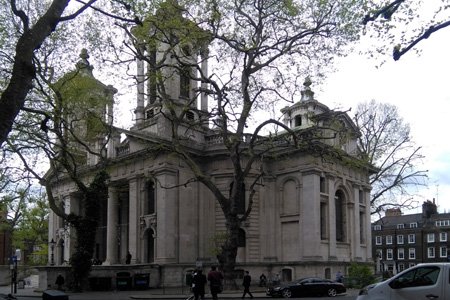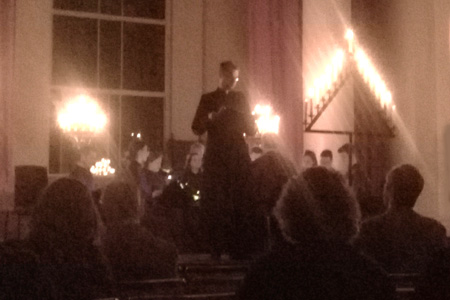| |
 |
 |
 |
| Comment on this report, or find other reports. |
 |
| Our Mystery Worshippers are volunteers who warm church pews for us around the world. If you'd like to become a Mystery Worshipper, start here. |
 |
| Find out how to reproduce this report in your church magazine or website. |
|
|
| 3153: St John's Smith Square, Westminster, London |
 |
 |
 |
Mystery Worshipper: Ken T. Poste.
The church: St John's Smith Square, Westminster, London.
Denomination: It used to be Church of England, though it has no formal ecclesiastical affiliation these days.
The building: Built in the 18th century in the English Baroque style, it is sometimes known as “Queen Anne’s footstool” as an apocryphal story relates to the building’s distinctive four corner towers being modelled on a footstool that had been kicked over in petulance. In truth, the four towers are an anti-subsidence measure. It was designed by English Baroque architect Thomas Archer as part of the Commission for Building Fifty New Churches set up by Act of Parliament in 1710 but falling somewhat short of its stated goal. The main door allows one to enter the side of the church underneath one of the balconies. As one enters, one is struck by the sheer size of the space, as the pillars are very much to the side, giving a cavernous feel to the building.
The church: In the early 20th century, the church was targeted as part of a suffragette bomb plot, yet it was later the venue for women's rights activist Emmeline Pankhurt’s funeral. The church was also the wedding venue for the parents of the composer Benjamin Britten. After the building was firebombed during the Second World War, it was sold to a charitable trust and was restored in the 1960s. Since then, it has no longer been used as the home of a church, instead becoming a concert venue, primarily for classical music.
The neighbourhood: Westminster is most notable as being the location of the UK government, with the Houses of Parliament just a few minutes walk from St John’s Smith Square. It has a rich spiritual as well as political history, with the Abbey (Anglican), Cathedral (Roman Catholic) and Central Hall (Methodist) all in close proximity. Despite the presence of these and other notable landmarks, which attract tourists from across the world, Westminster also has a substantial residential population. It is amongst these terraced houses where St John’s is located. Indeed, it may be found down one of several side streets and is unlikely to be stumbled across by accident, unless one is rather lost.
The cast: The service was led by the Tenebrae Choir, conducted by Nigel Short. Readings were given by the cleric-in-residence, the Revd Paul Dominiak, who is a theology tutor at Westcott House.
The date & time: Maundy Thursday, 13 April 2017, 10.00pm.
Comment:
We have received a comment on this report.
What was the name of the service?
It was billed as Maundy Thursday Liturgical Event though the header on the service sheet read Tenebrae Responses for Good Friday. It was one of a series of Holy Week programmes.
How full was the building?
There were about 50 people excluding the choir. Most were dotted about in ones and twos; there were no large groups. It's a massive building; even if 500 people had come, there’d still be room for more.
Did anyone welcome you personally?
There had been another concert finished just a few minutes before I came in, so I was somewhat hesitant as to whether we were allowed in. But as I made my way up the stairs, a young gentleman dressed all in black beckoned me in and handed me a service sheet.
Was your pew comfortable?
The individual leather seats were very nice.
How would you describe the pre-service
atmosphere?
Hushed anticipation.
What were the exact opening words of the
service?
There was no greeting, either formal or informal. The service went straight into the choral music. The first spoken words came from a reading from Matthew’s gospel but weren’t spoken until quite a long way into the service.
What books did the congregation use during the
service?
We had a service sheet that had English translations of some of the Latin psalms and responses, along with an outline of what was happening at each stage. It was not stated what translation of the Bible was used for the gospel and epistle readings.
What musical instruments were played?
No musical instruments were played. The Tenebrae Choir sang a cappella. A very large organ sat dormant at the back of the building.
Did anything distract you?
One of the candle stands was a bit wonky.
Was the worship stiff-upper-lip, happy clappy, or
what?
It was solemn, verging on the sombre. Almost the entire service was sung by the choir, with the only congregational participation coming with the saying of the Lord's Prayer near the end of the service. There was an alternation between music and readings. At the start of the service, a triangular stand called a hearse was set up, with candles lit down two of the sides of the triangle, with a single candle at the apex. As the service went on, these candles were extinguished one by one until only the one candle remained. This was supposed to be hidden, though the Revd Paul merely sat holding it in plain sight. Before the Miserere Mei was sung, all the rest of the candles in the building were extinguished, which was meant to plunge the building into darkness, though the light from nearby street lamps flooded in through some windows. After the Miserere Mei, the choir repeatedly stamped their feet, symbolic of the strepitus, mimicking the earthquake that occurred at the moment Jesus died. The lone candle was then placed back on top of the hearse.

Exactly how long was the sermon?
No sermon.
Which part of the service was like being in
heaven?
The singing was, as might be expected from a professional choir, outstanding. But of all the pieces they did, there was a superb rendition of a piece by Thomas Tallis that set some of the Book of Lamentations to music. Even though it was in Latin, thus rendering the lyrics incomprehensible to most, it was a thing of utter beauty.
And which part was like being in... er... the other place?
One of the highlights of any Tenebrae service should be the singing of Allegri's Miserere Mei, a Latin rendition of Psalm 51. It is a wonderful piece in multi-part harmony with some of the most extraordinary high notes from the sopranos. But the Tenebrae Choir chose not to do the Allegri setting; in fact, what they did wasn't even polyphonic. It was just two male parts singing alternate lines using what may have been a psalm tone – I wasn't sure. It was dull, lifeless and a major disappointment.
What happened when you hung around after the service looking lost?
There was no time for that. People filed out in silence. I was one of the last ones to leave. As I descended the steps on the outside of the building, I heard the door slam shut behind me. No one hung around outside; we all dispersed into the chill springtime night.
How would you describe the after-service
coffee?
There were no refreshments on offer.
How would you feel about making this church your regular (where 10 = ecstatic, 0 = terminal)?
N/A – As there is no regular church community here, it is impossible to say. I would, however, like to hear the Tenebrae Choir sing again.

Did the service make you feel glad to be a
Christian?
No.
What one thing will you remember about all this in seven days' time?
The most disappointing rendition of the Miserere Mei I've ever heard. |
|
|
 |
 |
 |
| We rely on voluntary donations to stay online. If you're a regular visitor to Ship of Fools, please consider supporting us. |
 |
 |
 |
| The Mystery Pilgrim |
 |
| One of our most seasoned reporters makes the Camino pilgrimage to Santiago de Compostela in Spain. Read here. |
 |
 |
 |
| London churches |
 |
| Read reports from 70 London churches, visited by a small army of Mystery Worshippers on one single Sunday. Read here. |
| |
|
|
|
|


